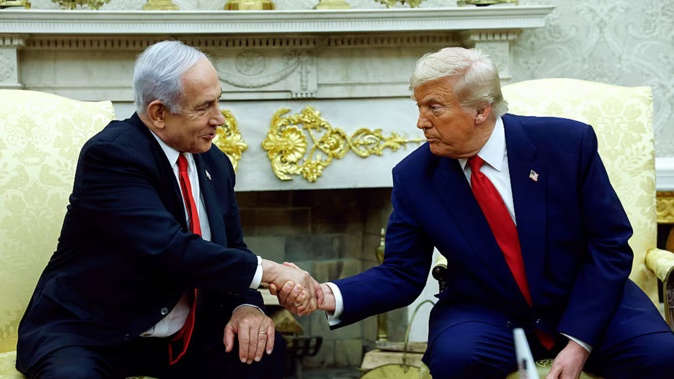
United States President Donald Trump hosted Israeli Prime Minister Benjamin Netanyahu at a dinner today, with the two meeting at a key moment and lavishing praise on each other amid efforts to reach a ceasefire in Gaza and determine the course of negotiations with Iran.
“I want to express the appreciation and admiration not only of all Israelis, but of the Jewish people,” Netanyahu said.
He then presented Trump with a letter he said he wrote nominating the President for the Nobel Peace Prize.
“You deserve it,” Netanyahu said as Trump read the letter, approvingly.
“Coming from you in particular, this is very meaningful,” Trump said.
In a notable shift, Trump also pledged to send more weapons to Ukraine to aid the country in its war against Russia, saying they would be aimed at helping their defensive capabilities.
“We’re going to send some more weapons. We have to,” he said.
“They have to be able to defend themselves. They’re getting hit very hard now. They’re getting hit very hard. We’re going to have to send more weapons.”
The White House visit is Netanyahu’s third since Trump took office less than six months ago and was scheduled to be far more understated than his previous visits before it was opened to reporters at the last minute.
Trump and Netanyahu sat at a long table in the Blue Room of the White House, their aides next to them and place settings for dinner in front of them.
- Trump urges 60-day Gaza ceasefire deal ahead of Netanyahu visit
- Israeli air strikes kill 17 in Gaza, including three children
- US-backed Gaza aid group says five members killed

Donald Trump pledged more weapons to Ukraine, emphasising their defensive needs against Russia. Photo / Getty Images
During an extended session with reporters, both leaders spoke of a need for shorter term agreements, but differences were still clear in their approaches to any long-term solutions.
Trump said that additional talks with Iran were scheduled, something his aides indicated would happen in the next week or so. Netanyahu, however, indicated that tensions were still lingering.
The US and Israeli attacks on Iran led to “a historic victory”, Netanyahu said.
“And I think as we sit here today, this has already changed the face of the Middle East,” he said.
“And I hope – I’d like to believe that Iran would not, test our fortitude, because it would be a mistake.”
Trump expressed optimism for a ceasefire between Israel and Hamas, saying, “They want to meet and they want to have that ceasefire”.
But asked about the possibilities of a two-state solution that would give Palestinians control, Trump said he didn’t know and that it was a question for Netanyahu.

Benjamin Netanyahu expressed hope for expanding the Abraham Accords and a potential ceasefire deal with Hamas. Photo / Getty Images
The Prime Minister made it clear that he would stop far short of agreeing to the full statehood Palestinians have sought.
“I think the Palestinians should have all the powers to govern themselves, but none of the powers to threaten us,” Netanyahu said.
“And that means that certain powers like overall security will always remain in our hands.
“We’ll work out a peace with our Palestinian neighbours – those who don’t want to destroy us, and we’ll work out a peace in which our security, the sovereign power of security, always remains in our hands,” he added.
“Now, people will say it’s not a complete state. ‘It’s not a state. It’s not that’ – we don’t care. You know, we vowed never again. Never again is now. It’s not going to happen again.”
Netanyahu met earlier in the afternoon with Secretary of State Marco Rubio and then with Steve Witkoff, Trump’s special envoy to the Middle East and an architect of the proposed ceasefire deal.
Witkoff plans to travel to Doha this week to continue negotiations, Leavitt said, and Trump has expressed hope that a ceasefire deal can be wrapped up this week.
Netanyahu plans to stay in Washington for much of the week to meet members of Congress, Pentagon officials, and Vice-President JD Vance.
“I think we’re close to a deal on Gaza. Could have it this week,” Trump told reporters yesterday.
“I think there’s a good chance we have a deal with Hamas during the week pertaining to quite a few of the hostages. You know, we’ve [got] a lot of the hostages out, but pertaining to the remaining hostages, quite a few, we think we’ll have that done this week.”
The President has also expressed hope of expanding the Abraham Accords, reached during his first term.
Under an expanded version of the accords, Israel could normalise relations with other countries in the Middle East, such as Saudi Arabia.
That has appeared unlikely, but Netanyahu said before his departure that “the opportunity to expand the circle of peace [is] far beyond what we could have imagined before”.
Yohanan Plesner, president of the Israel Democracy Institute, said several factors – in Israel, the wider Middle East and Washington – have laid the groundwork for what could be the most significant diplomatic shake-up in the Middle East since the 1970s.
“Since the early ’70s when [President Richard] Nixon and [Secretary of State Henry] Kissinger re-engineered the architecture of the region, we have never been closer to an entire rearrangement of regional diplomacy and posture,” Plesner said.
“For decades, things have been very stagnant, and now possibilities are opening up that we thought were unimaginable for decades.”
Part of the momentum has to do with Trump’s strategies, he said, but Israel’s military successes – beginning with the decimation of Hezbollah’s leadership last year and including its performance in the 12-day war with Iran – also have dramatically changed the power relationships in the region.

Trump and Netanyahu hope the Abraham Accords could be extended. Photo / Getty Images
Jonathan Rynhold, the head of the political studies department at Bar-Ilan University in Israel, said there is “no doubt” that chances for a ceasefire have improved.
“Hamas is under immense pressure … And in Israel, public opinion has been against continuing the war,” he said.
“Netanyahu owes Trump” because of the US decision to join the attack against Iran’s nuclear programme, he added.
“If President Trump is upset, that also damages Netanyahu at home,” Rynhold said.
Trump said last week that Israel had agreed to the framework of a deal for a 60-day ceasefire that mediators hope will provide a window of calm in which to negotiate an end to the 21-month war.
Under the framework, a copy of which was obtained by the Washington Post, more than half of the 50 Israeli hostages remaining in the custody of militants in Gaza – believed to include roughly 20 alive and 30 dead – would be released in five stages over the course of a two-month truce, in exchange for an as-yet unspecified number of Palestinian prisoners.
The first release, on the first day of the ceasefire, would see eight living hostages freed. On Day 7, the bodies of five hostages would be released.
On the 10th day, according to the framework, Hamas would provide information about the medical conditions of the remaining hostages, while Israel would reveal information about the Palestinians it has detained from Gaza since October 7, 2023.
The remaining hostages would be released when a final peace settlement is concluded.
Israel is holding more than 2400 people from Gaza in administrative detention as “unlawful combatants”, according to Israeli rights group HaMoked.
That status strips detainees of rights, including the right to a lawyer, for long periods – allowing Israel to hold many of them in secret for months. Released detainees reported having been subjected to physical, psychological, and sexual abuse in Israeli prisons.
Prisoners from the West Bank are also expected to be released under the deal. If the ceasefire holds, additional exchanges would take place on days 30, 50 and 60.

Bodies of the Palestinians who lost their lives after the Israeli attacks are taken from the morgue of Al-Shifa Hospital for the burial procedures in Gaza City, Gaza. Photo / Getty Images
Also under the deal, Israeli forces would withdraw from parts of northern Gaza on the first day – and a week in, Israeli forces would pull back from parts of southern Gaza.
The exact boundaries of the withdrawal map have yet to be agreed upon. Hamas submitted amendments to the proposal to mediators last week, as part of what the group called a “positive response”.
One of the points of contention is Hamas’ desire for Israeli forces to withdraw all the way to the lines they held during a previous ceasefire this year, according to Ibrahim Madhoun, a Palestinian political analyst close to Hamas.
Hamas has not commented publicly on the changes it has sought, and multiple Hamas officials did not respond to questions. Since Israel broke the ceasefire in March, however, it has expanded the buffer zone officials say it intends to hold permanently inside Gaza.
Another potential sticking point: how humanitarian aid gets to Gaza’s civilian population. Hamas wants aid distributed through the United Nations and the Palestine Red Crescent Society, rather than through the Gaza Humanitarian Foundation, an operation backed by Israel and the United States and patrolled by private American security contractors that has largely taken over aid distribution inside Gaza since late May.
The war began after Hamas and allied militants attacked southern Israel on October 7, 2023, killing about 1200 in border communities and at military posts and capturing 250 hostages.

A potential Gaza ceasefire, Iran talks, were discussed at the White House. Photo / Getty Images
Israel’s ensuing assault on Gaza has killed more than 57,000 people and injured more than 136,000, according to the Gaza Health Ministry.
The toll does not distinguish between civilians and combatants, but the Gaza Health Ministry and outside analysts say women and children make up the majority of the dead.
Over the past 24 hours, 105 Palestinians have been killed in Gaza, according to the Gaza Health Ministry.
Take your Radio, Podcasts and Music with you









